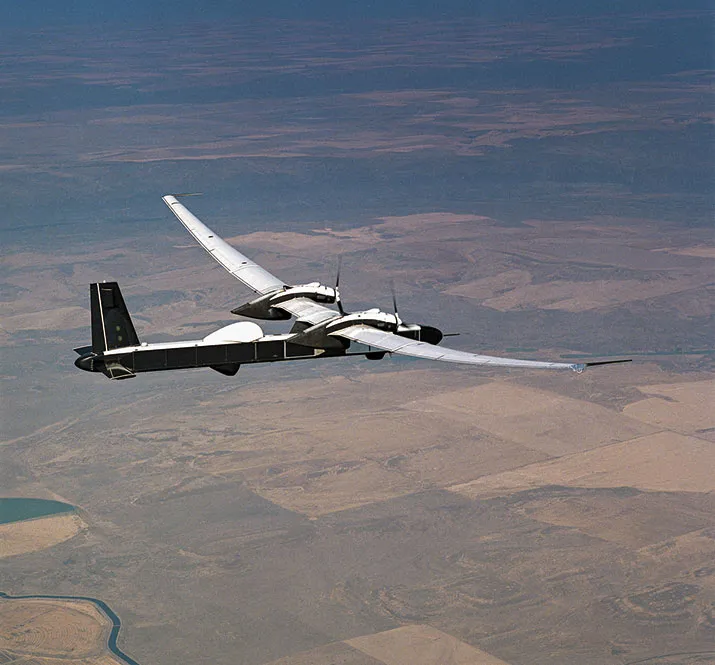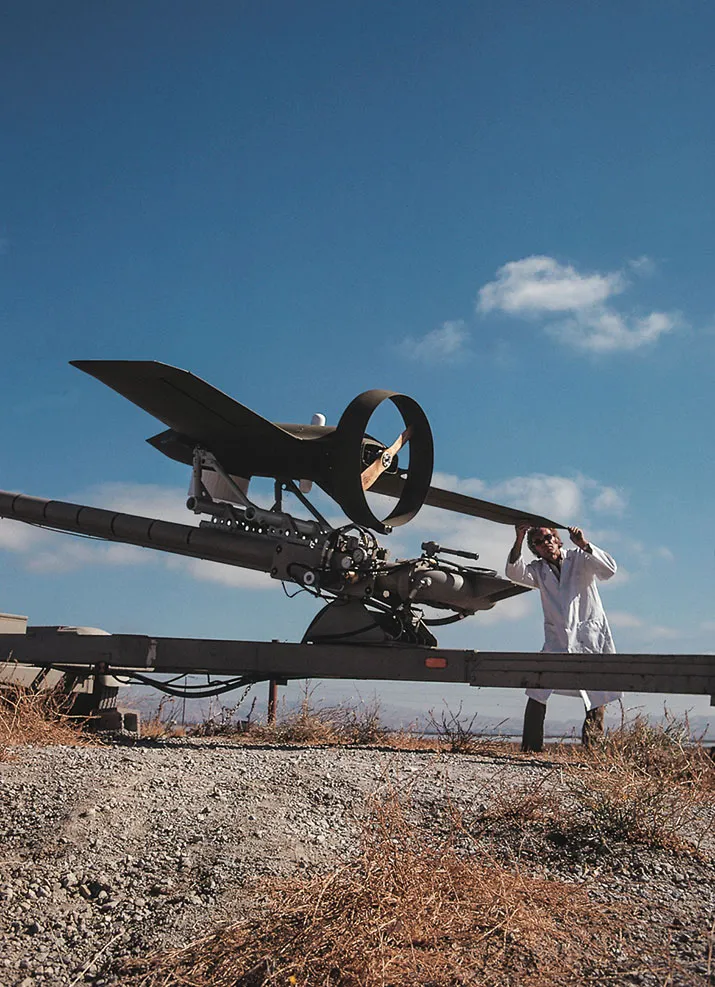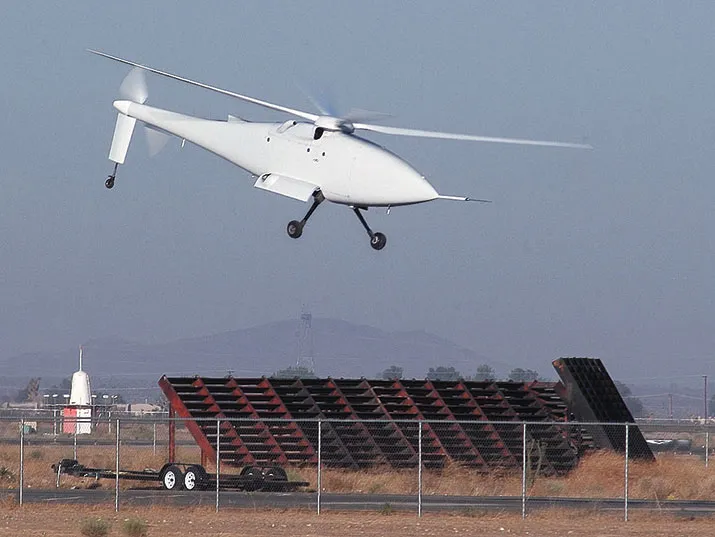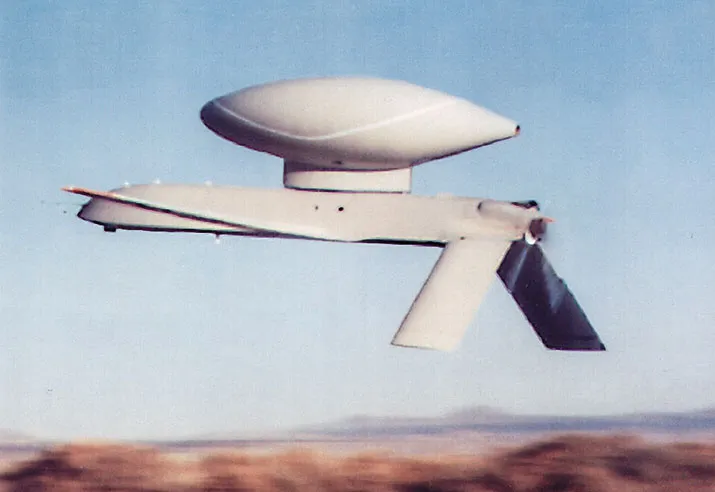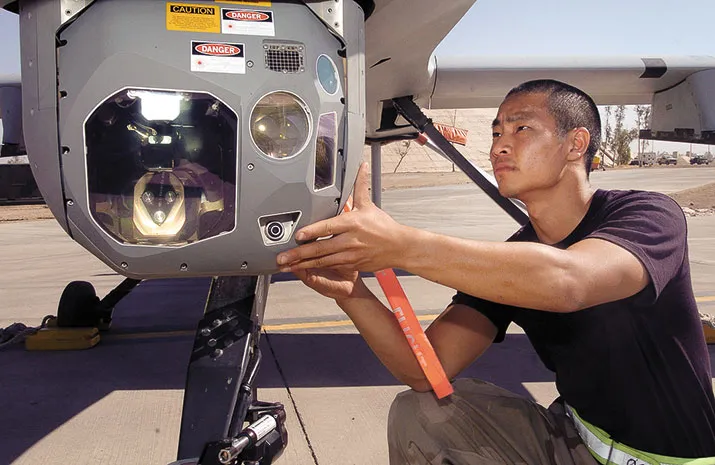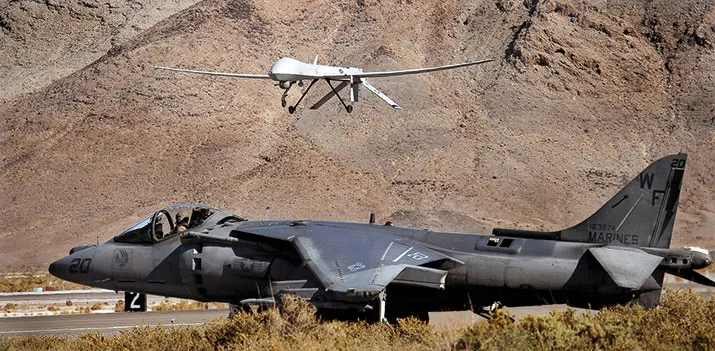The Man Who Invented the Predator
Before he designed the world’s most feared drone, Abraham Karem was just trying to get a robot to stay in the air
/https://tf-cmsv2-smithsonianmag-media.s3.amazonaws.com/filer/Drones-MQ-9-631.jpg)
The 40,000 square feet of office and engineering space occupied by Karem Aircraft Inc. in Lake Forest, California, includes four conference rooms, each named for a designer enshrined in the National Aviation Hall of Fame. There’s one for Kelly Johnson of the Lockheed Martin Skunk Works, one for helicopter inventor Igor Sikorsky, a third for aviation legend and flying-wing designer Jack Northrop, and another for Douglas Aircraft genius Ed Heinemann. “People who should make us humble,” says company owner Abe Karem.
“There should be an ‘Abe’ conference room,” observes one of Karem’s 13 employees, showing me around the facility while Abe—as everyone calls him—is busy elsewhere.
Undoubtedly the name “Abraham E. Karem” will one day join his conference-room heroes in the hall of fame in Dayton, Ohio. Karem is the designer of the Predator, the unmanned aerial vehicle that turned drones from unreliable oddities into military necessities, starting a technological revolution that is now spreading to civil aviation. Last year, Congress ordered the Federal Aviation Administration to lay the groundwork for opening the National Airspace System to unmanned aircraft.
Early the next morning, Karem arrives. Wearing a sport shirt and slacks and serving me a cup of coffee he’s fetched himself, he hardly acts the irascible genius some acquaintances have described. “I’ve never met a genius,” he playfully assures me as we sit down in the Kelly Johnson room for an interview that will last all day and into the evening. Most conversations with Karem require stamina; his answers are long and filled with parables and philosophy. “I always have metaphors,” he apologizes after one diverting discourse. “If you don’t get it, tell me to stop.” But he doesn’t really mean it.
Karem’s most famous invention is in service with the U.S. and Italian air forces and is currently causing controversy because of its use by the CIA for targeted killings. The Predator is also already on permanent display at the Smithsonian Institution’s National Air and Space Museum, though it hardly looks like an aircraft that was destined to change the world. Constructed of graphite epoxy composites and lighter than an economy car, the MQ-1 Predator, built by General Atomics Aeronautical Systems Inc. (GA-ASI) of Poway, California, is powered by a four-cylinder Rotax 914 piston engine—an Austrian motor used in ultralight sport aircraft—and cruises at a snailish 84 mph. With long, thin wings that stretch 55 feet 9 inches, just more than twice the length of its 27-foot fuselage, the Predator looks less like a warplane than a weekend hobbyist’s glider. Hobbyist sailplanes, though, don’t have turrets under their chins to hold electro-optical and infrared video cameras or noses stuffed with synthetic aperture radars and satellite antennas. Nor do their wings carry laser-guided AGM-114 Hellfire missiles—a key feature added by the Air Force in 2001, seven years after Karem finished his work on the remotely piloted airplane.
No matter how unlikely the Predator looks, its success has changed military aviation. When the Predator fired its first missile in combat—over Afghanistan on October 7, 2001—the U.S. military had a mere handful of UAVs. Today, the armed services own nearly 8,000. Drones of all sizes are now integral to combat operations, primarily providing intelligence, surveillance, and reconnaissance.
Prior to the Predator, though, UAVs were an aviation afterthought. The U.S. military had experimented with pilotless airplanes as “aerial torpedoes” or flying bombs as far back as the first world war, but with no great success—until the Vietnam war, when jet-propelled, camera-equipped drones built by Teledyne-Ryan were launched and controlled from U.S. Air Force C-130s on reconnaissance missions too risky for manned flights. Meanwhile, the CIA and the then-secret National Reconnaissance Office attempted to develop high-altitude, supersonic spy drones to overfly the Soviet Union and China. The efforts were too ambitious, though, for available technology (see “Hitchhikers,” June/July 2012).
During the 1970s and ’80s, UAV development across all U.S. military services cycled through a pattern: high expectation, disappointing performance or budget-busting cost, and withdrawal of support. The necessary technologies—composite materials, microprocessors, digital flight controls, satellite navigation, and broadband satellite communication—were either immature, outrageously expensive, or yet to be invented. In 1975, the Army awarded Lockheed Martin a contract to design a drone for artillery targeting: The MQM-105 Aquila was launched by catapult and recovered in a net. In 1987, after spending $1 billion on the program, the Pentagon cancelled it. Boeing’s extraordinary, high-altitude, long-endurance UAV, the Condor, suffered a similar fate. With a wingspan twice that of a U-2, the manned aircraft it was intended to replace, the Condor began in the late 1970s as an initiative of the Defense Advanced Research Projects Agency (DARPA) and was a useful technology test bed. It reached 67,000 feet and demonstrated an endurance of 60 hours, but only one was built. Today it hangs in the Hiller Aviation Museum in San Carlos, California. The U-2 is still in service.
In the meantime, Abraham Karem was growing frustrated with Israel’s military acquisition system. Born in Iraq on June 27, 1937, Karem was raised in Israel, where his father took his wife and four sons—Abe was the third—when the Jewish state was founded after World War II. A precocious child, Abe felt loved and encouraged growing up, even when, as a toddler, he pulled the back off a large standing radio and pulled out the big vacuum tubes, one by one, to “see where is the man who talks from there.” As that memory suggests, Abe fell in love with engineering early in life.
“I am a toy man,” he explains. “What motivates me from the time I was a kid—call it technology, call it whatever—it was play. By the age of eight, I knew I’m going to be a mechanical engineer. And oh my God, by the age of 13 or 14, I fell in love with aeronautics. At 14, I started building model aircraft. Within two years, I was the instructor in the [high school] aero club.” Later, he earned a private pilot’s license.
Karem’s aeronautical engineering degree is from Israel’s renowned Technion institute of technology. He remembers his professors as idealists, working together to build a society and secure its survival. Their attitude of selfless common cause stayed with him. Karem’s belief in the power of teamwork has been a trademark of his career.
“I built three wonderful teams in Israel,” he boasts. “I built two here.” On the first team he built in the United States, he adds, were several engineers who today are technical leaders and executives at Predator-maker General Atomics, including company president Frank Pace, who once “was the closest thing to my right-hand man.”
While at the Technion, and as an air force officer for nine years afterward, Karem learned to design and maintain real aircraft but also continued his childhood interest in models. He entered free flight model competitions and world championships, in which entrants strive for the longest flight under a complex set of rules. After the air force, Karem joined Israel Aircraft Industries, where he rapidly made his way toward the top. Within four years, and while still in his 30s, he was in line to be named executive vice president for engineering, he says, but decided to strike out on his own.
There were several reasons for moving on, but among them was an epiphany he’d had in late 1973, while working on an urgent air force request to design a radar-fooling drone decoy. The project came to naught because Israel ended up buying decoys from the United States, but by working on it, Karem came to see unmanned aircraft as unconquered territory. In early 1974, despite protests and warnings from higher-ups, he left IAI and started a company of his own to design UAVs.
Karem’s departure from IAI was the first major manifestation of a maverick streak that has been a source of lift to his career but also a source of drag. He has escaped corporate culture and holds more than 20 patents to show for it—on aircraft designs, mechanical devices, material production methods, and subsystem innovations—but his ability to see things in a new light has also made him impatient with those who fail to grasp his insights.
“Gentlemen, everything I see in this room is nonsensical,” one longtime associate recalls Karem telling a roomful of engineers at a major defense company who had invited him in to discuss collaboration on a project. Then he closed his briefcase and walked out. A Karem friend remembers a meeting where Abe called a group of defense acquisition officials “clerks.”
“Abe has no problem telling others what’s on his mind, that’s for sure,” says Martin Waide, who has worked for Karem more or less steadily since 1979.
The politics of defense contracting, along with his occasionally prickly personality, have conspired to keep some of Karem’s best designs from being accepted by the military. After leaving IAI, Karem spent three years offering the Israeli military one UAV design after another without making a sale. The government—sole shareholder in IAI, whose executives didn’t appreciate his departure—was never going to buy anything from Abe Karem, he finally concluded. Frustrated, he decided to try his luck in the United States, where he knew opportunities for entrepreneurs were far greater. His wife, Dina, whom he’d met when she was an engineering draftsperson in the Israeli air force, backed his decision, as she has supported other big risks he’s taken during their 46 years of marriage.
In 1977, to gain a foothold in the U.S. aerospace industry, Karem took a position with a tiny Los Angeles company called Developmental Sciences Inc., which had offered Israel a drone decoy in 1973 and was now working on projects that included a DARPA-funded UAV. Shortly thereafter, Karem set out on his own again. When he took Dina house hunting, she realized Abe was going to be working at home.
“I’m looking for a house with a garage attached,” she told him. “You’re looking for a garage with a house attached.”
They found a garage Abe liked, attached to a house on a hill in Hacienda Heights, a suburb east of Los Angeles. The garage had 600 square feet of floor space and an equally spacious attic. By 1981, both spaces were crammed full of tools, computers, and handmade molds to fabricate aircraft parts from lightweight composites such as fiberglass and carbon epoxy. Working with Abe in the garage were two other believers in UAVs: Jack Hertenstein, a brainy, bashful engineer and radio control modeler Karem had met at Developmental Sciences, and Jim Machin, a pre-med student who’d impressed Abe at a free-flight modeling meet.
The trio produced a UAV demonstrator that was feather-light—it weighed only 200 pounds—and would carry a television camera in its nose. Hertenstein contributed avionics and ground control, and, Karem says, “tremendous expertise in flying his automated model aircraft without crashing.” According to DARPA calculations, it would stay aloft a stunning 56 hours. Karem named it Albatross.
During Karem’s brief stay at Developmental Sciences, he had met Ira Kuhn, a technology entrepreneur who visited the company to evaluate its UAV on DARPA’s behalf. In the course of conversation, Kuhn described an engineering problem he had been working on. A few days later, Karem called him with a solution. “It was extremely clever and much better than mine,” Kuhn recalls. Kuhn kept in touch, and was so impressed by the Albatross that he told DARPA director Bob Fossum, “This guy is a national asset.”
DARPA ended up funding the Albatross flight tests. The drone’s exceptional performance led the agency in 1985 to contract with Karem’s new company, Leading Systems Inc., to develop a larger endurance UAV the agency named Amber. Navy Secretary John Lehman was pushing the development of UAVs as spotters for the guns on Navy ships. Largely financed by the Navy, Amber also had champions in U.S. Southern Command, who wanted “persistent surveillance” of drug traffickers in Latin America, recalls former DARPA official Bob Williams, who initiated the project.
Thus were the seeds of the drone revolution sown. The Predator, though nearly twice as large, is a direct descendant of Amber, as their near-identical configurations suggest. Amber’s thrust came from a two-blade wooden propeller at the rear of the fuselage. Its tricycle landing gear retracted into its body. The V-shaped stabilizers at its tail pointed downward. Karem chose that distinctive feature mainly for aerodynamic stability but also because, in a rough landing, the stabilizers could hit the ground and skid, keeping the propeller blades from shattering on the runway.
Like the Albatross, Amber was radio controlled and could be configured to take off and land like conventional aircraft or fold its wings and stabilizers for launch by rocket from a canister. Most ingenious of all, Amber could be recovered by putting it into a “deep stall”—a feature used in free flight glider models to escape thermal updrafts and stay within flight time limits. The stall would bring Amber to “a near-vertical landing so it could be used from small ships, submarines or trucks/trailers,” Williams explains.
By 1988, Karem was expecting to build large numbers of the UAV for the Navy. With GPS becoming available and other key technologies gaining momentum, interest in UAVs was growing. Leading Systems now occupied 200,000 square feet of industrial space in Irvine, California, and had a contract on an airfield near El Mirage Dry Lake. In June of that year, an Amber flew over El Mirage at 5,500 feet above sea level for 38 hours. Even so, the Navy dropped a plan to buy 200, and the Army rejected the aircraft when Karem offered it as a short-range UAV, a mission in which endurance was no advantage. Around the same time, piqued by the money spent on programs like Aquila and Condor, which failed to develop useful and affordable UAVs, Congress froze funding for such programs and created a joint program office to consolidate drone development. DARPA transferred Amber to the joint program office, which promptly cancelled it.
Developing a useful and affordable UAV, however, is precisely what Karem had done. His achievement, says Bob Williams, “was not a high-aspect-ratio wing, good aerodynamics, or a lightweight structure, although good designers could do those things, and Abe could do them better than most. The issue really was reliability. Manned aircraft fly for tens of thousands of hours without crashing. So how do you even get in that ballgame? The crowning success of Amber was that by the end of the program, we were able to fly 650 hours without a loss. That was a huge order of magnitude increase in reliability [over other UAVs at the time].”
When Amber’s future looked unsure, Karem shifted his focus to a lower-tech export version his team had been working on with private funding: the Gnat-750. The number refers to the chord of the wing in millimeters at its root, a dimension of the airfoil from leading to trailing edge. The Gnat was bigger, heavier, and less capable than Amber, with a two-stroke Rotax 532 engine and no canister launch capability. While Karem tried to make a foreign sale, a $5 million bank loan came due.
Alerted to the opportunity by a mutual friend, the owners of General Atomics, brothers and reputed billionaires Neal and Linden Blue, bought the assets of Leading Systems out of bankruptcy in 1990. Their company, which had been working on its own UAV with minimal success, got everything Karem had achieved with Amber and Gnat, Karem says. The Blue brothers, lifelong aviators and entrepreneurs who also saw unmanned aircraft as a beckoning frontier, hired Karem and eight of his people, getting “a team that was flying advanced UAVs like nobody else,” Karem boasts.
A few years later, when the Clinton administration was desperately looking for a way to monitor ethnic conflicts in the Balkans, CIA chief James Woolsey remembered Karem, whom he’d met and come to admire years earlier. “Abe’s an entrepreneurial engineering genius,” says Woolsey today. “He lives to create.” The CIA bought two Gnat-750s with video cameras and started flying them over Bosnia. They were launched from Albania, where their ground control station and operators were located. As that was happening, the Department of Defense held a competition for the right to demonstrate in actual missions a more advanced “medium-altitude endurance” UAV. One requirement was that the aircraft have a satellite antenna so it could be flown by operators who were much farther away than those flying the Gnat, which over Bosnia had to relay its signals to Albania through a piloted, motorized glider.
To make room for the satellite antenna, Karem gave the Gnat-750 a nose job, adding a big upward bulge. The only other major changes were a Rotax 912 engine (upgraded later to the 914), heavier landing gear, and a wing chord that measured 1,100 mm (43.25 inches) at the root. The new craft wasn’t armed, but GA-ASI’s then-president, former fighter pilot and retired rear admiral Thomas J. Cassidy, decided they should call it Predator, the name the company had used for its pre-Karem UAV.
A competition among four entrants ended with a $31.7 million contract, awarded to General Atomics in January 1994, to deliver three Predators and a ground control station within six months and more within another year. Predator crews became the first combatants in history able to spy on and, eventually, kill an enemy from the opposite side of the globe.
Given its impact, the Predator alone might warrant hall of fame honors for Karem—even if the RQ-1/MQ-1’s ultimate success owes as much to General Atomics and an obscure Air Force office nicknamed “Big Safari,” which armed Karem’s invention and devised a communications system to let operators fly it and launch its missiles from a dozen time zones away. The Predator, though, is only the most prominent contribution Karem has made to aviation in a career that has spanned five decades.
Shortly after leaving General Atomics—eager to pursue new projects, he departed a month before the Predator’s first flight—Karem began work on what is now Boeing’s A160 Hummingbird UAV, the first helicopter whose rotor changes its speed over a large range of revolutions per minute without excessive vibration or instability, gaining cruise and hover efficiency and reducing noise by always turning at optimum rpm.
Karem attracted Army interest in the A160 but was told the service would trust only a major company with its production. In 2004, determined to see the craft built in quantity, he reluctantly sold his company, Frontier Systems, to Boeing for an undisclosed sum. Then he watched, chagrined, as the Army cancelled the program this year, citing cost and technical risk.
“Boeing and the Army both badly misjudged the maturity of the A160 at the time of transfer,” says Benjamin Tigner, Karem Aircraft’s director of integrated systems. Tigner was vice president of engineering at Frontier Systems and served as Boeing’s chief A160 engineer for a year and a half before leaving Boeing to work on his own, which he did for five years before rejoining Karem in 2010.
Tony Tether, who as DARPA director from 2001 to 2009 was also interested in the A160, agrees with Tigner’s analysis. “It will come back,” says Tether. “This is too good an aircraft to not come back.”
Karem remains undaunted. He’s now spending a large part of the proceeds from the sale of Frontier Systems on developing a 737-size tiltrotor. The helicopter-airplane hybrid, which would use optimum-speed rotors akin to the one he patented for the A160, is meant to compete with regional jets. Bloodied but unbowed, Karem is marketing his tiltrotor to the military too.
“The things he attempts to do are things in which he thinks he can make a gigantic leap forward somehow,” says Tigner.
Martin Waide says that Karem looked at the helicopter industry and saw opportunities to improve performance—in efficiency, noise reduction, range, payload. “And with no previous build experience, [he] set about in short order and built the A160, which did indeed demonstrate all those things.”
Karem says those who think the secret to the Predator’s success was endurance should think again. What he brought to UAVs, he says, was a refusal to treat them—as others had—like models or target drones, which aren’t built to last, and therefore aren’t built to be reliable. He designed the Albatross, Amber, Gnat-750, and Predator to fly hundreds of hours without a crash. He adds “I’m not a genius, but I am probably one of the best aircraft designers in the world today.”
Author Richard Whittle is writing a book on the Predator for Henry Holt and Company.

